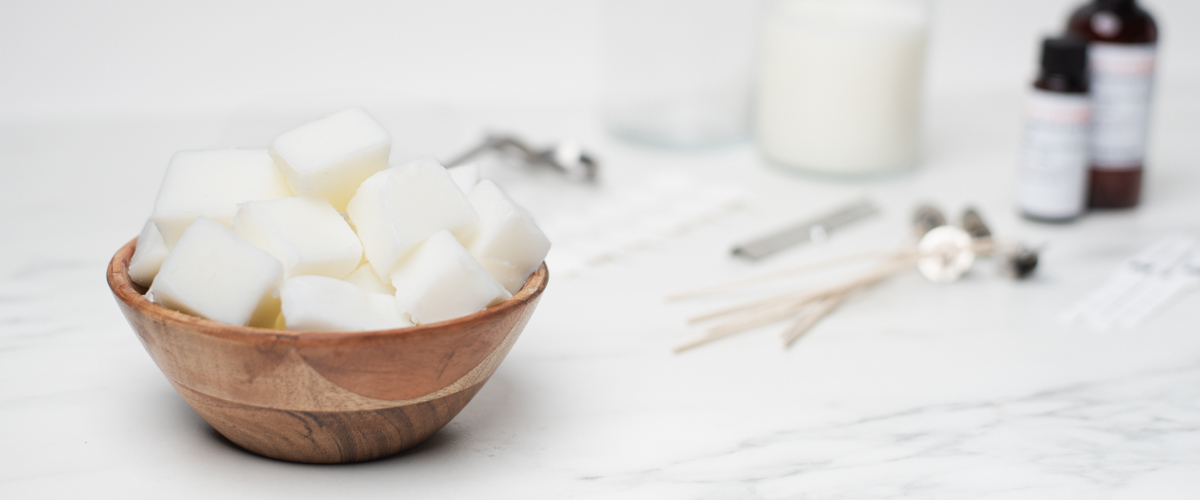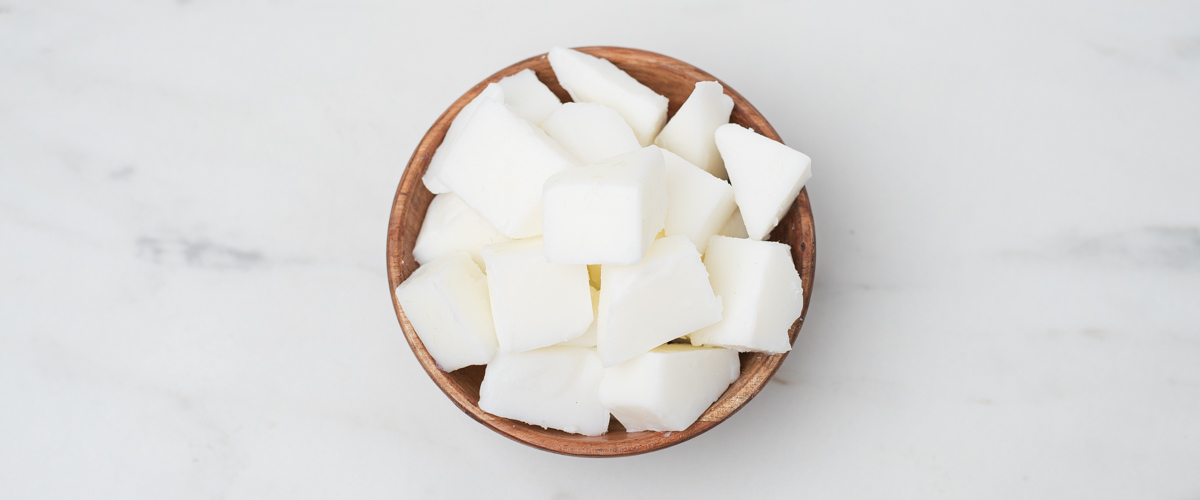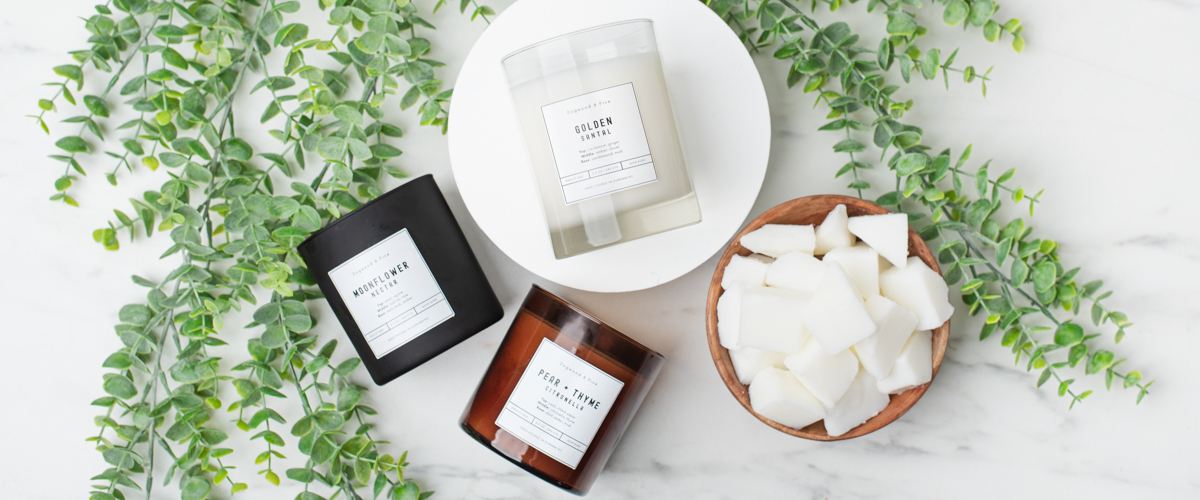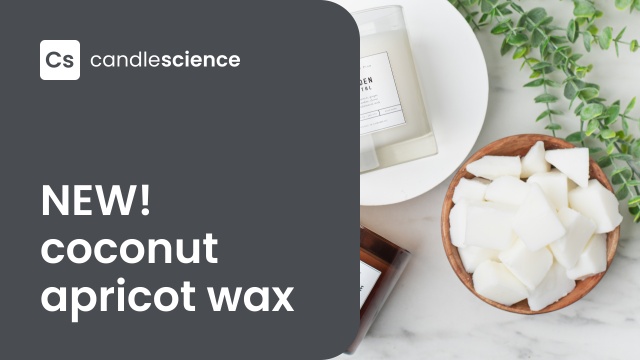Lab notes: CandleScience Coconut Apricot Wax A custom-made, single-pour, high-fragrance throw container wax

Our testing process
We divided our testing into four parts:
- Aesthetics: We tested for glass adhesion, frosting, and color issues.
- Fragrance Performance: We looked at fragrance solubility, retention, and cold and hot throw performance.
- Burn Performance: We tested various wick series and sizes to find the best burn.
- Stability: We exposed samples to hot and cold environments.
For the fragrance testing segments, we used White Tea, Jamaica Me Crazy, Smoked Oud, and Beach Linen fragrance oils. They have different densities, viscosities, and ingredients. We hoped the variation would reveal potential solubility and burn issues.
Application: This wax is intended for container candles.
Recommended Fragrance Load: Up to 15%
General overview
This custom, single-pour wax was formulated in the CandleScience lab and is manufactured in the USA. We developed this blend of soy, coconut, apricot, and paraffin wax for consistently smooth tops, excellent fragrance throw, and optimal burn performance. It is available in soft, easy-to-cut slabs.

Aesthetics
Surface and glass adhesion
We tested pour temperatures ranging from 145°F (62.8°C) to 185°F (85°C). We achieved our best overall results pouring this wax at 175°F (+/- 5°F) or 79.4°C (+/- 2.5°C) in an ambient room temperature of 70°F.
We consistently achieved smooth, level tops in our test candles on the first pour. Some had very slight dipping near the wick, but they did not require refinishing. While container size/shape and environmental conditions are always a factor, it’s possible to achieve excellent surfaces with a single pour, even at various pouring temperatures.
Glass adhesion is highly dependent on the environment, pouring temperature, container, and fragrance oil. This wax is prone to shrinking as it cools, which can cause the wax to either partially or fully pull away from the glass during the cooling process. Test candles made with no fragrance consistently pulled away from the glass. Adding fragrance softens the wax, which can minimize shrinking and lead to better glass adhesion. Many of our test candles made with 10% fragrance had full glass adhesion after 24 hours, while others developed areas where the wax pulled away, commonly known as wet spots. These spots were visible after 24 hours and often increased in size after 1 week in our test environment.
Complete pull away can be just as visually appealing as full adhesion. Pouring at 145° – 155°F (62.7°C – 68.3°C) can promote shrinking and cause the wax to uniformly pull away from the glass.

Frosting
This wax is formulated to be highly resistant to frosting. While frosting is always possible with natural wax blends, we saw no signs of frosting in our test candles.
Coloring
This wax makes it easy to create beautifully colored candles that won’t be tarnished by frosting. When using equal amounts of dye, our Coconut Apricot wax produces colors that are slightly deeper and more vibrant than a pure soy wax, such as 464. We tested four different colors of liquid dye at 6 drops per pound of wax and achieved the following results:
- Red Liquid Candle Dye: medium shade of pink
- Blue Liquid Candle Dye: medium shade of blue
- Yellow Liquid Candle Dye: medium shade of yellow
- Black Liquid Candle Dye: medium shade of gray

Fragrance performance
Solubility
The fragrance oil incorporated easily when added to the wax at 190°F (+/- 5°) or 87.8°C (+/- 2.5°C). After 24 hours, we looked for any signs of sweating or oil separation in the finished candles. At percentages up to 15%, the wax successfully held all of our test fragrance oils.
Fragrance oil use will contribute to the melting point of the finished candle. Higher fragrance loads can potentially cause issues when shipping in warm climates (see Stability).
Hot and cold throw
We conducted olfactive testing with a 6% fragrance load. The cold throw was strong after just 24 hours, and improved slightly after 1 week of curing. Each fragrance was consistently rated 3/3 for cold throw among testers. The hot throw of this wax exceeded our expectations. We allowed the burn testers to cure for 3 days, then burned them in our in-house fragrance testing booths.
Every fragrance we tested was easily a 3 on our 3-leaf rating scale. When tested side-by-side with 464, the Coconut Apricot provided a stronger fragrance throw.
Burn performance
General burn characteristics
This wax has a longer softening range than most vegetable blends, so it does not have the sharp melting point seen with 464 and other pure soy waxes. This allows unmelted wax to slide down the inside wall of the container as the candle burns. As a result, melt pools do not need to extend across the entire surface of the candle. Unlike pure soy, which will often leave wax behind if a full melt pool is not reached, this wax does not require an edge-to-edge melt pool in order to completely consume the wax by the end of the candle’s life.
This wax has a lower viscosity when liquid than pure soy wax, allowing it to travel through the wick more quickly. This means it will generally need a smaller wick than soy wax to avoid bringing too much fuel to the flame. This also means you can typically get the same size melt pool as soy wax with a smaller flame.
Wicking
We tested this wax with various sizes of AL, LX, CD, and ECO wicks. Because of the complex blend of natural waxes and paraffin, any of these series could be a potential match.
The AL, or Aroma-Lite®, series is ideal for smaller candles or candles with multiple wicks. In our burn testing the AL wicks unfurled a tiny bit at the top as they burned and this lends towards slightly larger carbon heads. This means you need to be more diligent about trimming wicks or use a taller necked tab - say 10 mm. This really applies more when the flame height is approximately ¾” (19mm) or bigger. A benefit of the larger carbon head is that it spreads the base of the flame out and gives you a slightly larger melt pool at a smaller flame height. These wicks can be used in either a container or pillar (Any free standing wax). They do not curl so the melt pool stays centered on the wick location
The LX series performed well in our testing. While they are more likely to create a mushroom head on the end of the wick, this provides a wider base to the flame, which can help reduce smoke and soot while still maintaining a proper melt pool. The LX series is available in many sizes to accommodate containers of varying size and shape. Because they are designed to stand straight with a minimal curl as they burn, they are the ideal choice when making multi-wick candles.
The CD series also did well in our testing. They are available in a wide variety of sizes, and the pronounced curl helps to inhibit carbon buildup. Because they create less significant mushroom heads than LX, they generally need a taller flame to achieve a full melt pool, which can lead to more flickering and smoking on average.
The ECO series has too few size options to provide an ideal burn profile in every circumstance. Although still a viable option in some cases, ECO wicks will not always provide the best results when using various sizes and shapes of containers. This series has also been found to diminish in performance when using high fragrance percentages, so we recommend using them with fragrance loads of 10% or less.
Stability
We conducted stability testing in both hot and cold environments to determine the impact of temperature on the finished candle. We tested with fragrance loads ranging from 6% to 15%.
Finished candles were first placed in a freezer for 24 hours, then removed and returned to room temperature. We checked for any changes in the appearance of the wax, as well as signs of oil separation. All of our test candles successfully retained fragrance with no syneresis. Syneresis occurs when droplets of liquid (in this case, fragrance) rise to the surface and may or may not absorb. Again, this was not a problem for this wax. The only significant change in appearance was related to glass adhesion. The wax consistently shrank when left in freezing temperatures, which caused it to either partially or fully pull away from the glass.
Candles were also placed in an oven at 113°F (45°C) for 24 hours. For this test, candles are laid on their sides and observed for signs of slumping, melting, or fragrance separation. Using fragrance percentages up to 13%, all of our test candles retained their shape and fragrance oil throughout the heating process. However, some of our test candles with a 15% fragrance load melted out of the containers within the 24 hour period. The wax was collected during the process and, upon cooling to room temperature, retained the fragrance oil. While the wax can hold fragrance oil up to 15%, the resulting candle may have a melting point that is too low for transport in hot climates.
the more fragrance you use in your candles the more likely the container will melt in extremely hot shipping weather. We recommend storing your candles upright as much as possible.

How to market your candles
How to market your candles is a decision made by you, the maker, based in part on your target audience—who you want to buy your products. CandleScience Coconut Apricot Wax is unique in that it can fit into multiple markets. Apricot wax blends are a desirable, on-trend product for consumers and our wax doesn’t carry the high-price point of other apricot blends on the market. That means you could advertise this wax as part of your luxury product lineup or stick to storytelling through this wax’s amazing hot throw.
Marketing your products as luxury items is all about your customer’s perceived value of your product. What is perceived value? It’s the value a customer places on your brand and products. That value can be built by the fragrance, container, packaging, and story told by your product—just for starters! To help you decide how to position your product, we recommend reading how to price your candles to help you establish your target audience first.
You can also take your candles to the next level by learning how to select fragrances that elevate your collection.
And, when it comes to labeling, we recommend following our Essential Guide to Candle Label Requirements and using our partner Avery WePrint to print your labels. CandleScience customers save 10% on every order!
Flush Packaging offers custom boxes for many of CandleScience’s candle containers. Custom shipping boxes can be an effective way to elevate your brand while protecting your product.
